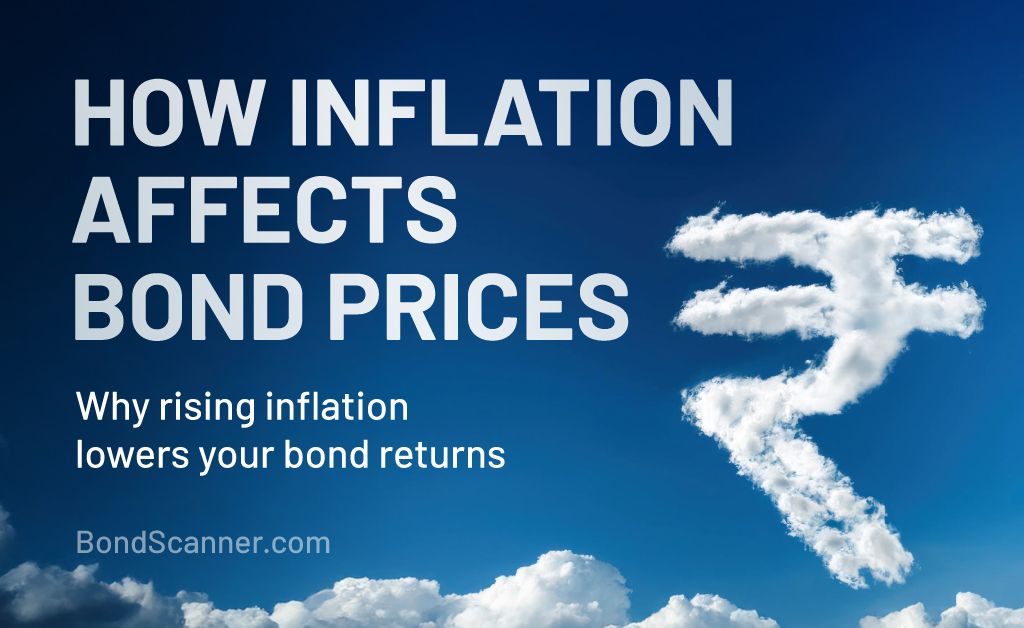How Inflation Affects Bond Prices
31 October 2025

What Is Inflation?
Inflation is one of the most crucial factors influencing the bond market. While bonds are known for providing fixed income and stability, their value can fluctuate with changes in inflation rates. Understanding how inflation affects bond prices helps investors make informed decisions and manage expectations from their bond portfolios.
This article explores the relationship between inflation, interest rates, and bond prices — and how these dynamics shape the performance of bond investments in India.
Inflation refers to the general increase in prices of goods and services over time, which reduces the purchasing power of money. In simple terms, when inflation rises, each rupee buys fewer goods than before.
Central banks, including the Reserve Bank of India (RBI), aim to maintain inflation within a target range (typically around 4% in India) to ensure economic stability. However, when inflation climbs above this level, it can significantly influence bond yields and prices.
What Are Bonds and How Do They Work?
A bond is a fixed-income security that represents a loan made by an investor to a borrower — usually a government or corporation. When you invest in a bond, the issuer promises to pay periodic interest (called the coupon) and repay the principal at maturity.
For example, if you purchase a bond worth ₹10,000 at an 8% coupon rate, you’ll earn ₹800 in annual interest until maturity. However, the real value of that ₹800 depends on the prevailing inflation rate.
If inflation rises to 6%, your real return (adjusted for inflation) is only 2%. This simple illustration shows how inflation can impact bond investors’ purchasing power.
The Relationship Between Inflation and Bond Prices
Inflation and bond prices share an inverse relationship. When inflation rises, bond prices generally fall. Here’s why:
1. Rising Inflation Leads to Higher Interest Rates
To control inflation, the RBI may increase policy rates. Higher interest rates make newly issued bonds more attractive since they offer better yields compared to existing bonds. Consequently, the market value of older bonds with lower coupon rates declines.
2. Erosion of Fixed Income Value
Since bondholders receive fixed interest payments, the real value of these payments decreases when inflation rises. Investors demand higher yields to compensate for this erosion, pushing down existing bond prices in the secondary market.
3. Market Expectations and Bond Yields
Bond yields reflect the return an investor expects based on market conditions. If inflation expectations increase, yields rise — and since yields and prices move inversely, bond prices drop.
Illustration: Inflation Impact on Bond Prices
| Year | Inflation Rate | Bond Coupon | Market Interest Rate | Bond Price Trend |
|---|---|---|---|---|
| 2022 | 4% | 7% | 7% | Stable |
| 2023 | 6% | 7% | 8% | Price Falls |
| 2024 | 3% | 7% | 6% | Price Rises |
Difference Between Primary Market and Secondary Market
| Feature | Primary Market | Secondary Market |
|---|---|---|
| Definition | Bonds are issued for the first time by governments or companies. | Bonds are traded between investors after issuance. |
| Participants | Issuer and investors. | Investors (buyers and sellers). |
| Price | Fixed by the issuer at the time of issue. | Determined by demand, supply, and market interest rates. |
| Example | Government launches a new bond issue. | An investor sells an existing bond on the exchange. |
Why Inflation Impacts Different Bonds Differently
Not all bonds react to inflation the same way. Factors like bond type, tenure, and coupon rate determine sensitivity to inflation.
1. Short-Term vs. Long-Term Bonds
Long-term bonds are more sensitive to inflation changes because they lock in fixed returns for extended periods. Short-term bonds are less affected since they mature sooner, allowing reinvestment at newer rates.
2. Fixed-Rate vs. Floating-Rate Bonds
Fixed-rate bonds suffer more during inflationary periods because their coupons remain unchanged. Floating-rate bonds, on the other hand, adjust periodically based on prevailing interest rates, offering partial protection against inflation.
3. Government vs. Corporate Bonds
Government bonds (like G-Secs) are considered safer but may see more price volatility in response to inflation trends. Corporate bonds often offer higher yields to offset inflation risk.
How Investors Can Manage Inflation Risk in Bonds
While inflation can erode bond value, investors can adopt certain strategies to mitigate its effects:
Diversify Bond Tenure: Combine short, medium, and long-term bonds to balance risk and returns.
Consider Floating-Rate or Inflation-Indexed Bonds: These adjust payouts based on inflation or interest rate movements.
Monitor Inflation and Policy Trends: Keeping track of RBI policy updates helps anticipate market direction.
Focus on Credit Quality: Invest in bonds rated by reputed agencies (AAA, AA, etc.) to reduce default risk.
Reinvest Coupons Wisely: Reinvest interest income in higher-yielding instruments during inflationary phases.
Inflation’s Broader Economic Impact on the Bond Market
Persistent inflation can also reshape the broader bond market:
Yield Curve Shifts: Inflation expectations may cause the yield curve to steepen as long-term yields rise faster than short-term ones.
Foreign Investment Flows: High inflation can reduce foreign investor appetite for Indian bonds, affecting liquidity.
Government Borrowing Costs: Rising inflation increases the cost of government borrowing through bond issuance.
These macroeconomic effects highlight why inflation is a key factor for policymakers and investors alike.
FAQs
1. What happens to bond prices when inflation rises?
When inflation rises, bond prices usually fall because investors demand higher yields to compensate for reduced purchasing power.
2. Are any bonds protected from inflation?
Inflation-indexed bonds and floating-rate bonds offer partial protection since their interest rates adjust in line with inflation or benchmark rates.
3. Does inflation affect government and corporate bonds differently?
Yes. Government bonds may see price changes due to interest rate adjustments, while corporate bonds may also face credit spread changes during inflationary periods.
4. How can investors manage inflation risk in bonds?
By diversifying bond portfolios, monitoring policy changes, and considering short-term or floating-rate bonds, investors can reduce inflation-related risks.
5. Is inflation always bad for bond investors?
Not necessarily. Moderate inflation can indicate economic growth, which supports stable interest payments and improves bond market liquidity.
Conclusion
Inflation plays a vital role in determining bond prices and yields. Understanding its impact helps investors assess risk, maintain portfolio balance, and set realistic expectations. While inflation can reduce the real value of bond income, a well-diversified and informed approach can help mitigate these effects.
At BondScanner, investors can explore rated bonds from reputed issuers, with transparent data on yields, maturities, and credit ratings — enabling informed decision-making in India’s evolving bond market.
Disclaimer
This blog is intended solely for educational and informational purposes. The bonds and securities mentioned herein are illustrative examples and should not be construed as investment advice or personal recommendations. BondScanner, as a SEBI-registered Online Bond Platform Provider (OBPP), does not provide personalized investment advice through this content.
Readers are advised to independently evaluate investment options and seek professional guidance before making financial decisions. Investments in bonds and other securities are subject to market risks, including the possible loss of principal. Please read all offer documents and risk disclosures carefully before investing.
Recent Blogs

Covered Bonds & Senior Secured Bonds Explained
An educational guide explaining covered bonds, senior secured bonds, what secured bonds mean, and how these instruments function in India’s bond market.
19 Dec 2025

Guide to Capital Gain Bonds (54EC) & Alternatives
An educational guide explaining capital gain bonds under Section 54EC, issuer options like PFC and SBI, eligibility rules, and alternatives for reinvesting sale proceeds.
19 Dec 2025

Bond ETFs in India: How They Work & When to Use Them
An educational guide explaining bond ETFs in India, their structure, returns, risks, and how products like Bharat Bond ETF and corporate bond ETFs function.
19 Dec 2025